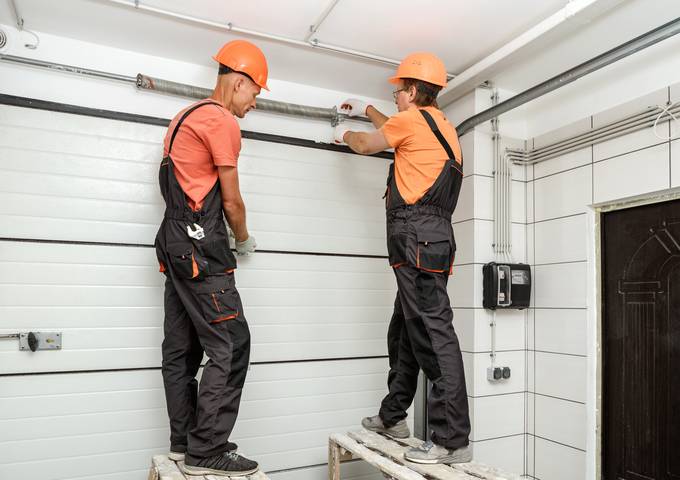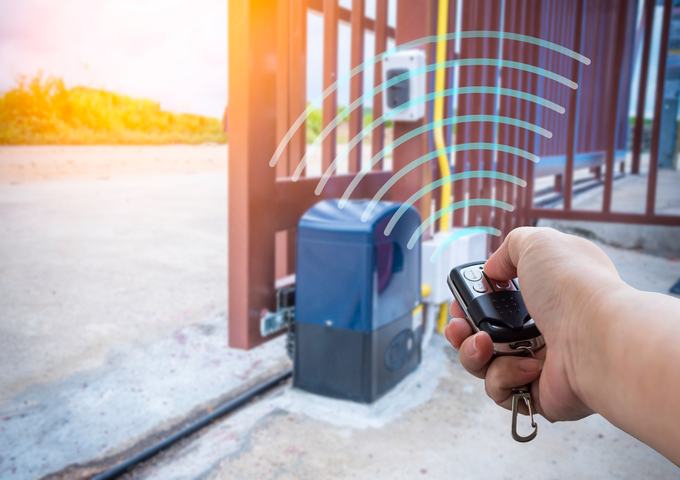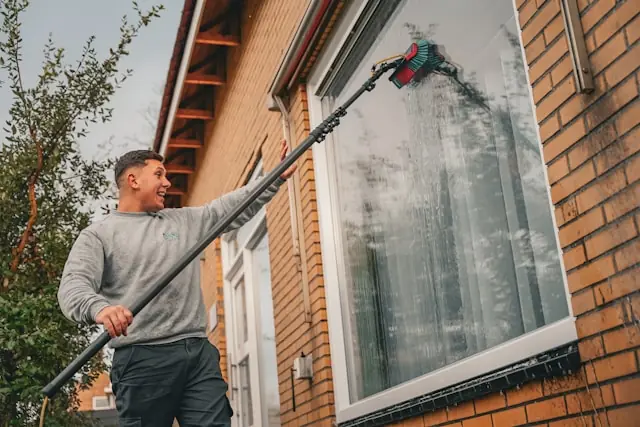A battery backup garage door opener keeps your day moving when the power doesn’t.
Storms, outages, and tripped breakers happen.
With the right setup, your car gets in and out safely, and your home stays accessible.
Why Backup Power Matters
Garage access is a safety issue, not only a convenience.
Emergencies rarely wait for electricity.
A backup system ensures you can open and close the door, protect valuables, and get family members where they need to go.
A battery backup garage door opener also protects smart-home routines.
If your opener integrates with cameras, sensors, or deliveries, backups help maintain continuity.
You avoid manual overrides and reduce the risk of leaving the door unsecured during blackouts.
How Backups Work
Most solutions use a DC motor with an external or integrated battery.
When power fails, the battery drives the motor for several cycles.
Electronics prioritize essential functions, preserving charge for opening and closing safely.
A battery backup garage door opener typically supports multiple door cycles per charge.
Cycle counts depend on door weight, spring balance, temperature, and battery health.
Expect fewer cycles in extreme cold and more with well-balanced doors and fresh batteries.
Types of Backup Systems

Some models include built-in batteries inside the powerhead.
These are tidy, simple to install, and monitored by the opener’s firmware.
Others use add-on battery modules that mount near the rail or on a wall.
A battery backup garage door opener can also pair with external inverters.
Whole-home batteries or portable power stations convert DC to AC.
The opener sees “grid power,” while your battery system silently covers the outage.
Integrated vs. Add-On
Integrated batteries simplify maintenance and monitoring.
You get alerts through the opener’s app when health drops.
Add-on packs are flexible, letting you choose capacity or upgrade later.
A battery backup garage door opener with an add-on pack is handy for older units.
You avoid replacing a perfectly good opener.
Check motor type, current draw, and compatibility before buying any external battery kit.
Dedicated Battery vs. Power Station
Dedicated opener batteries are compact and optimized for door cycles.
Portable power stations offer versatility for tools, fridges, and electronics.
Pick based on your household priorities and outage risk profile.
A battery backup garage door opener plus a compact power station covers more scenarios.
If an outage runs long, you can recharge the station via solar.
That lets you keep operating the door beyond typical cycle limits.
Choosing the Right Capacity
Capacity determines how many cycles you’ll get.
Heavier doors use more energy.
Insulated double doors may drain batteries faster than lightweight single doors.
A battery backup garage door opener should comfortably handle frequent trips.
Plan for daily commutes, deliveries, and emergencies during a 24-hour outage.
If you rely on the garage as a primary entrance, choose a larger capacity.
Compatibility Considerations
Motor type matters.
DC motors are inherently friendlier to backups and soft-start features.
AC motors can work with inverters, but may be less efficient during outages.
A battery backup garage door opener should match your rail system and door balance.
Poorly balanced doors strain the motor and slash cycles.
Have a technician verify spring tension before trusting any backup estimate.
Installation Pathways

Many homeowners can install pre-matched backup kits.
They plug into the opener and fasten with brackets.
Follow the manufacturer’s wiring and mounting guidelines for safety.
A battery backup garage door opener might require professional wiring in some jurisdictions.
Hardwired options or whole-home battery tie-ins should meet code.
Licensed installers ensure proper circuit protection and ventilation.
Safety First
Backups must preserve safety sensors.
Photo-eyes should remain aligned and tested after installation.
Never bypass sensors to “save power”; it’s unsafe and unnecessary.
A battery backup garage door opener should still do a force-reversal test.
Use a 2×4 under the door to confirm reversal on contact.
Schedule periodic tests, especially after storms or service work.
Maintenance and Testing
Batteries are consumables.
Expect three to five years of service for sealed lead-acid packs.
Lithium variants can last longer with proper thermal management.
A battery backup garage door opener benefits from monthly tests.
Run one cycle on the battery to confirm readiness.
Keep terminals clean, check charging indicators, and replace packs proactively.
Performance in Cold and Heat
Temperature swings affect battery chemistry.
Cold reduces capacity; heat accelerates wear.
Install away from direct sunlight and insulate shared walls where possible.
A battery backup garage door opener can keep performing in winter with planning.
Consider a slightly higher capacity if you live in cold climates.
Store portable power stations in conditioned spaces.
Smart Features and Alerts
Modern openers pair with smartphone apps.
You’ll get battery health alerts, outage notices, and remote control.
Some systems let you schedule test cycles and view detailed logs.
A battery backup garage door opener with Wi-Fi is more transparent.
You’ll know when the grid fails, even away from home.
Combine push notifications with security camera snapshots for full awareness.
Cost and Value
Entry-level backup modules are affordable.
Integrated premium openers cost more but add quiet drives and smart features.
Power stations vary widely by capacity and brand.
A battery backup garage door opener quickly pays for itself in peace of mind.
Avoid lock-outs, costly emergency service calls, and security risks.
For remote workers, uninterrupted access can be priceless during outages.
Environmental Considerations
Recycling matters.
Lead-acid and lithium batteries require proper disposal.
Use certified drop-off points or retailer take-back programs.
A battery backup garage door opener with efficient charging reduces waste.
Smart charge profiles extend battery life.
Solar-recharged power stations cut grid dependence and emissions.
When to Replace
Diminishing cycle counts and slow lifts are warning signs.
If the opener strains or the lights dim on battery, service is due.
App diagnostics can confirm declining capacity.
A battery backup garage door opener should recover quickly after restoration.
If it doesn’t hold a charge or recharges abnormally slowly, investigate.
Replacement is cheaper than dealing with a stuck door in an emergency.
Alternative Approaches
Counterweight and spring tuning reduce energy needs.
A well-balanced door is easier on any motor or battery.
Annual tune-ups keep everything efficient.
A battery backup garage door opener can pair with a manual quick-release plan.
Teach family members how to pull the cord safely.
Practice once a year, so no one panics during a real outage.
Legal and Insurance Factors
Some regions mandate backup access for attached garages.
Insurance policies may reward risk-reducing features.
Check local codes and talk to your provider.
A battery backup garage door opener demonstrates proactive risk management.
Document installations and maintenance.
This helps claims and proves responsible home stewardship.
For Multi-Car Households
Two doors mean double the decisions.
Back up both, or at least one primary exit.
Coordinate schedules and who parks where to minimize outage friction.
A battery backup garage door opener for the primary bay covers daily needs.
Keep a portable power station for the second door.
That strategy balances cost and resilience.
For Remote and Vacation Homes

Outages may last longer in rural areas.
Smart alerts are invaluable when you’re away.
Combine backups with cameras and trusted neighbors.
A battery backup garage door opener lets property managers access during storms.
Deliveries, repairs, and inspections proceed without delay.
You maintain security while granting controlled access.
Common Mistakes to Avoid
Don’t oversize without considering door balance.
Fix mechanics before throwing capacity at the problem.
Avoid mixing mismatched third-party batteries with proprietary chargers.
A battery backup garage door opener needs correct wiring.
Use surge protection to shield electronics.
Label circuits and keep manuals handy for quick troubleshooting.
Realistic Expectations
Most systems are designed for several open-close cycles.
They are not meant for continuous operation.
During long outages, conserve cycles and plan recharges.
A battery backup garage door opener becomes part of a layered plan.
Pair with flashlights, UPS units for routers, and phone chargers.
Prepared homes ride out blackouts gracefully.
Pros and Cons Summary
Pros: guaranteed access, safety, security, convenience, and smart alerts.
Cons: upfront cost, maintenance, and eventual battery replacement.
Most homeowners find that the benefits easily outweigh the downsides.
A battery backup garage door opener is simple insurance.
It turns unpredictable outages into minor inconveniences.
Your garage stays usable, your schedule stays intact.
Installation Checklist
Verify door balance and spring health.
Confirm opener compatibility and current draw.
Choose a capacity for your expected outage profile.
A battery backup garage door opener installation should include labeling.
Note install date, battery type, and replacement reminder.
Test sensors, Wi-Fi alerts, and manual release after setup.
Maintenance Calendar
Monthly: one battery-only cycle and sensor test.
Quarterly: terminal inspection and debris cleaning.
Yearly: professional tune-up and force-reversal test.
A battery backup garage door opener lasts longer with discipline.
Log results in a simple notebook or app.
You’ll spot trends and replace before failures.
Budgeting and Upgrades
Start small with a matched battery module.
If outages are frequent, add a power station.
Consider a quiet belt-drive DC opener at the next upgrade.
A battery backup garage door opener pairs well with LED lighting.
Efficient lights reduce draw during battery operation.
Look for openers with high-efficiency power supplies.
One-Time Use of Similar Keywords
If you’re retrofitting, consider a battery backup for a garage door opener kit.
Some households prefer a battery-operated garage door opener for simplicity.
Always maintain your garage door opener battery for reliability and safety.
Final Thoughts
Preparedness turns chaos into calm.
With the right plan, you’ll never be trapped by a powerless door.
Choose components wisely, maintain them, and test regularly.
A battery backup garage door opener is a small investment with an outsized impact.
It safeguards access, protects routines, and supports safety.
Power may fail, but your garage keeps working.
FAQs
How many cycles can I expect during an outage?
Most systems deliver several open-close cycles on a fresh charge.
Door weight, temperature, and balance affect results.
Plan for essential trips and conserve cycles during extended blackouts.
Do I need a professional to install backup power?
Many matched kits are DIY-friendly with clear instructions.
For hardwiring, whole-home batteries, or code-sensitive work, hire a pro.
Professionals ensure safe wiring, proper mounting, and compliance.
How often should I replace the battery?
Lead-acid packs typically last three to five years.
Lithium can last longer with good thermal conditions.
Replace at the first signs of diminished cycles or slow lifts.
Will backup power affect safety sensors or smart features?
Correctly installed systems preserve safety sensors and smart connectivity.
Test photo-eyes and force reversal monthly.
Apps often show health, outage alerts, and battery status.
What’s the best way to prepare for long outages?
Balance your door, test monthly, and keep a portable power station.
Consider solar charging for multi-day events.
Conserve cycles and prioritize essential trips until grid power returns.














Leave a comment